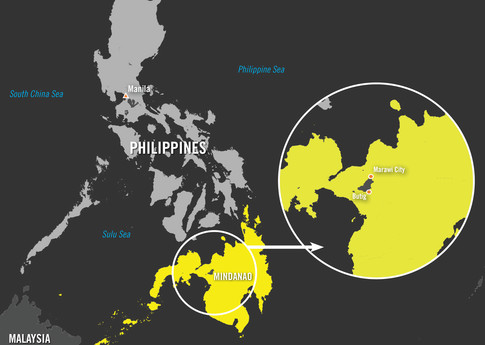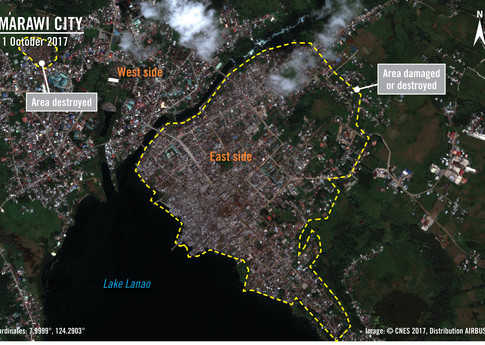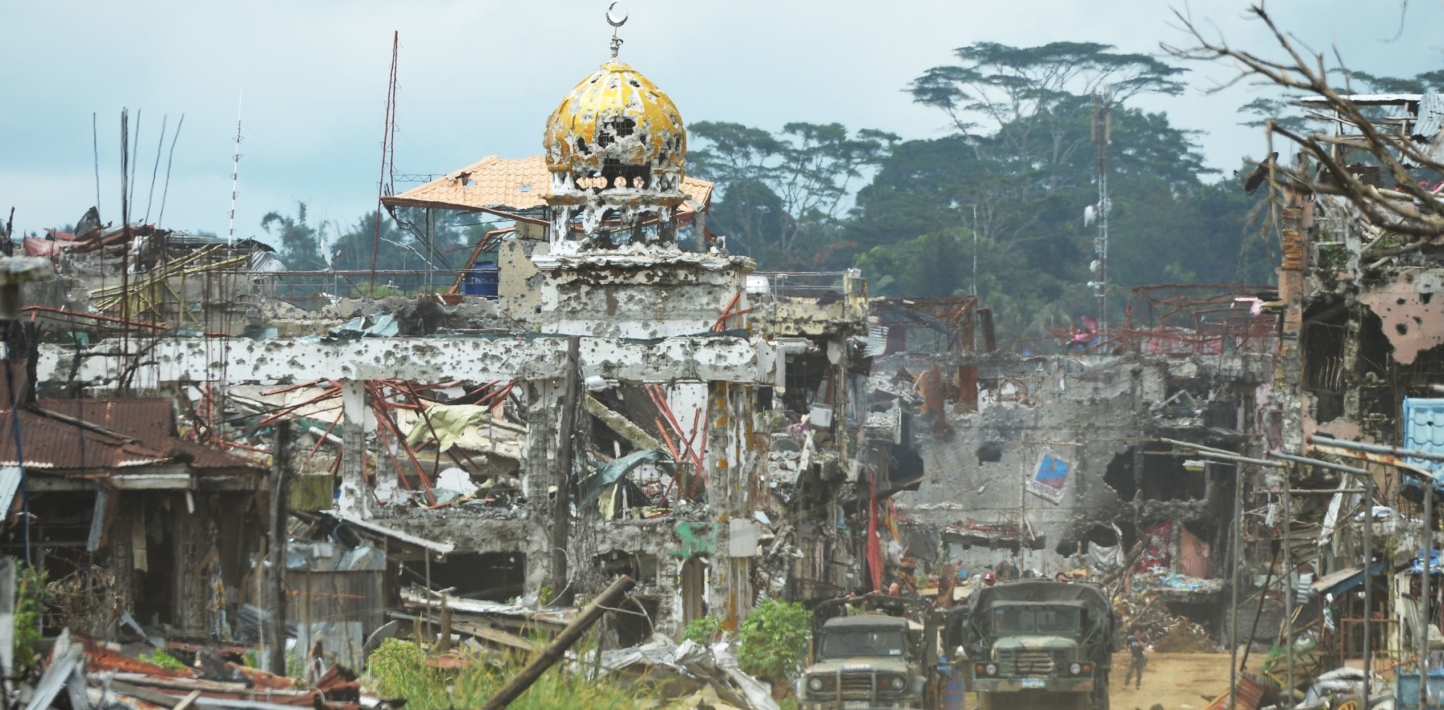Civilians on the island of Mindanao paid a high price with dozens killed and widespread destruction of homes and property amid the ‘battle of Marawi’ that pitted the Philippine military against militants allied to the armed group calling itself Islamic State (IS) between May and October this year, Amnesty International said in a report today.
The ‘Battle of Marawi’: Death and destruction in the Philippines is the first detailed human rights analysis of the conflict, based on a research trip to Lanao del Sur, Mindanao in September. It documents how IS-allied militants targeted Christian civilians for the worst of the abuses, including at least 25 extrajudicial killings, mass hostage-taking, and extensive looting of civilian property.
Philippine armed forces, meanwhile, detained and ill-treated fleeing civilians, and also engaged in looting. Their extensive bombing of militant-held areas of Marawi city wiped out entire neighbourhoods and killed civilians, highlighting the need for an investigation into its compliance with international humanitarian law.
“Marawi’s civilian population has suffered immensely amid one of the Philippine military’s most intensive operations in decades. Displaced en masse when the fighting began in May, thousands of people are now returning to a city that has been utterly destroyed in places, where civilians have been slaughtered by militants, and both sides have committed abuses,” said Tirana Hassan, Crisis Response Director at Amnesty International.
The IS-linked militants’ bloody, months-long siege of Marawi took a heavy toll on civilians, with Christians in particular singled out for brutal attacks, including grisly extrajudicial killings.
Tirana Hassan, Crisis Response Director at Amnesty International
“The IS-linked militants’ bloody, months-long siege of Marawi took a heavy toll on civilians, with Christians in particular singled out for brutal attacks, including grisly extrajudicial killings.”
Civilians targeted in reign of terror

Amnesty International interviewed 48 survivors and witnesses, and many described how IS-linked militants regularly targeted civilians and carried out extrajudicial killings in Marawi city.
Multiple witnesses described 10 separate incidents where militants killed a total of at least 25 civilians by shooting them or slitting their throats. Most were targeted because they were Christians, and some were killed as they attempted to flee to safety. It is a war crime to murder civilians.
During the morning of 23 May, Adam, in his forties, was in the car park of the Amai Pakpak Medical Hospital when he saw three militants hijack the hospital’s ambulance and execute the driver:
“I saw them stop the ambulance. They asked [the driver] to say the Shahada [an expression of Muslim faith], but the driver was not able to answer so they shot him… Then they came to me and asked me to recite the Shahada [and I did], and they let me live.”
I saw them stop the ambulance. They asked [the driver] to say the Shahada [an expression of Muslim faith], but the driver was not able to answer so they shot him… Then they came to me and asked me to recite the Shahada [and I did], and they let me live.
Adam, a man in his forties
A group of six painters, all Christian, hid in their employer’s house for five days after fighting broke out before attempting to escape. After being chased and fired at by militants, they took cover in a canal that led them to Lake Lanao.
Amnesty International interviewed two of the men. One of them said:
“When I was about to [swim across] the lake I saw ISIS [fighters] near… we were six that were supposed to cross the lake but three of our friends were shot… We saw the person shooting, he was [dressed] all in black with long hair and a beard.”
Survivors and witnesses told Amnesty International how militants also captured a large number of civilians as hostages. The militants subjected them to forced labour and used them as human shields. At least one hostage was summarily executed, and many were physically abused.
[After they captured us] they brought us to a mansion where they kept us hostage… In the mansion we were used as slaves, following their orders. We cooked, prepared food… If [we] didn’t follow their commands, they would hit us. Once they fired [a bullet] near my head.
A construction worker in his twenties
A construction worker in his twenties who was held hostage for several weeks along with dozens of other Christians told Amnesty International:
“[After they captured us] they brought us to a mansion where they kept us hostage… In the mansion we were used as slaves, following their orders. We cooked, prepared food… If [we] didn’t follow their commands, they would hit us. Once they fired [a bullet] near my head.”
The same hostage was later transferred to two other locations, each of which had many more hostages. One of those locations, a large building with more than 100 other hostages, was hit by an airstrike, killing 10 civilians.
Escape to detention and ill-treatment
In some instances, members of the Philippine military treated civilians who escaped militant-controlled areas with suspicion, detaining them and subjecting them to torture or other ill-treatment.
Amnesty International interviewed eight victims of such abuse at the hands of the Philippine armed forces. Seven of them were Christian construction workers who had been trapped in Marawi city because they feared being captured or killed by militants if they tried to escape.
One of the construction workers, a man in his forties, was shot at by militants on his first attempt to escape Marawi city, an attack which he believes killed three of his colleagues. On the second attempt, he and his companions were crossing a bridge to flee the militant-controlled area of the city when Philippine Marines confronted and detained them. He told Amnesty International:
“We thought that we were safe. But then the master sergeant arrived. Then they told us that we were ISIS…They beat us…I was punched and kicked…My companion showed his ID, but the military said he was a sniper for ISIS… I was beaten with an Armalite [rifle]… They tied our hands and feet with electrical wire. I was crying and they would not listen… The military was very angry because 13 of their men were killed.”
The Philippine armed forces detained another escaped civilian who was beaten severely all over his body, had the butt of a rifle smashed on his hands and back, and had burning-hot liquid poured all over his body. The pain eventually caused him to pass out and he was later handed over to the Red Cross.
Trapped under fire
Although the vast majority of civilians fled Marawi city in the first week of the conflict, hundreds or possibly even thousands remained trapped inside amid the ongoing fighting. On 29 May, the UN reported that 2,300 people remained in the city, dropping to fewer than 300 by late August, as many had managed to escape by then.
Many of the civilians trapped for extended periods were workers who were living in a state of fear, at risk of being found by militants and hit by bombs or bullets. An unknown number were reportedly killed by the government’s aerial bombardment.
We were not able to sleep because of the airstrikes and gunfire… For 38 days we drank rain water… I tried to escape but bombs were falling near our building… When we did finally leave, we saw dead bodies decaying in the street… When we arrived at the bridge … we were rescued by the military [and] were turned over to the police.
A married couple from Iligan who were trapped in Marawi
A married couple from Iligan who were trapped in Marawi city for more than five weeks told Amnesty International:
“We were not able to sleep because of the airstrikes and gunfire… For 38 days we drank rain water… I tried to escape but bombs were falling near our building… When we did finally leave, we saw dead bodies decaying in the street… When we arrived at the bridge … we were rescued by the military [and] were turned over to the police.”
Due to restrictions on access to Marawi city itself, Amnesty International was unable to determine whether the Philippine armed forces’ use of artillery and airstrikes breached their international humanitarian law obligations. Further independent investigation is needed to determine whether the infrastructure damage and the loss of civilian life was militarily necessary and proportional to the threat posed by the militants.
“The Philippine authorities must bring those responsible for torture and other violations to justice and ensure that the victims receive adequate reparations. They must also initiate a prompt, effective and impartial investigation into whether its bombing of civilian neighbourhoods was proportional under international humanitarian law,” said Tirana Hassan.
The Philippine authorities seem to be responding to concerns about looting by members of the security forces, with investigations and charges under way. They must also follow through on promises of compensation.

Background
On 23 May 2017, a firefight broke out between Philippine government forces and an alliance of IS-aligned militants in Marawi – a city of 200,000 in the Autonomous Region in Muslim Mindanao, in the southern Philippines.
The militants, including the Maute group and the Abu Sayyaf group, quickly took control of large areas of the city, prompting Philippine President Rodrigo Duterte to impose martial law and suspend the writ of habeas corpus on the entire island of Mindanao.
Within a month, the conflict displaced 360,000 people in Marawi and surrounding areas. Hundreds, if not thousands, of civilians remained in the besieged city for weeks or months, either as hostages or trapped in the crossfire.
The battle lasted for five months, and resulted in the mass displacement of civilians, the widespread destruction of civilian infrastructure, and the loss of civilian lives.
According to official figures, 920 militants, 165 soldiers and 47 civilians were killed in the fighting, and more than 1,780 hostages were rescued from the IS-linked militants. But restrictions on access to Marawi during the conflict have precluded any independent corroboration of these numbers.


